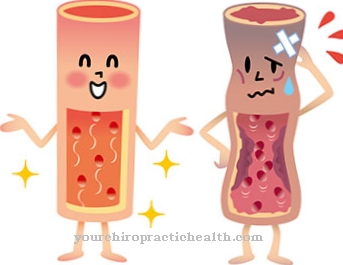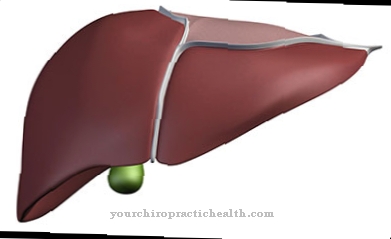Drug-induced headache belongs to the group of secondary headaches, which i. d. Usually caused by pain relievers or other drugs. This type of headache can be unilateral or bilateral. Drug-induced headache is generally good to treat.
What is drug-induced headache?
.jpg)
A drug-induced headache occurs when persistent headaches occur for at least 15 days per month. This headache occurs after taking pain reliever medication for more than 10 days per month for more than three months.
Drug-induced headache is not a primary, i.e. independent headache such as B. Migraines or tension headaches. However, the primary headache is a prerequisite for a drug-induced headache to develop.
There are three types of drug-induced headache: chronic migraine, chronic tension headache and chronic combination headache.
In addition to analgesics (pain relievers), other drugs can also cause drug-induced headaches. It must be taken into account here whether the drug was primarily used to treat headaches or for another disease, since the drug-induced headache can also occur as a side effect of long-term medication.
causes
The cause of drug-induced headache is a headache that has been excessively treated with painkillers. Typically, migraines and tension headaches are the primary headaches.
Not every form of headache automatically leads to drug-induced headache. Cluster headaches lead i. d. Usually, even with excessive use of analgesics, drug-induced headaches only in exceptional cases.
It should also be noted that painkillers taken for rheumatic diseases, injuries and other diseases are not considered to be the cause of drug-induced headaches.
Since it has not yet been possible to determine a specific cause for drug-induced headaches, it is assumed that a genetic predisposition is possible.
Typical symptoms & signs
- pressing, dull to stabbing (also throbbing) headache
- Photosensitivity
- Flicker before the eyes
- Sensitivity to noise
Diagnosis & course
The diagnosis is made drug-induced headache by the general practitioner as well as by the neurologist. After a detailed anamnesis, the affected person is i. d. Usually recommended to keep a so-called headache diary over a longer period of time.
In addition, a general physical examination and a blood analysis are performed. The neurologist examines the neurological status of the patient with the help of EEG and other neurological examination methods.
If the blood analysis reveals any abnormalities, an internist can also be called in. The kidneys and liver may have been damaged, especially after years of abuse of painkillers. The condition of the internal organs is determined with the help of further blood tests. Imaging methods such as ultrasound are also used to determine whether and to what extent there is damage to the organs.
The course of drug-induced headache can be described as good. With adequate therapy, the success rate is 80 percent.
Depending on how long the drug-induced headache has been present or how long the pain and drug abuse has been carried out, complications can arise in the further course. In addition to the liver and kidneys, stomach ulcers and stomach tumors can occur. People with drug-induced headache often have depression, which can be treated well with behavioral therapy.
Complications
With this complaint, the patient has a very severe headache. In most cases, these pains are usually stabbing or pressing and can therefore significantly reduce the quality of life. The concentration and coordination of the person concerned is also reduced by this complaint.
The pain often spreads from the head to other regions of the body and can also lead to discomfort there. Sometimes there is also a sensitivity to light, so that the headache is aggravated by bright light. Sensitivity to noise can also occur. Patients often have a flicker in their eyes and can no longer carry out their normal activities.
The symptoms themselves can be limited by simply stopping the respective medication or replacing it with another. Above all, those affected have to forego painkillers. This can also lead to withdrawal symptoms. If this complaint is not treated, it can lead to inflammation of the stomach or, in the worst case, to kidney failure, which is fatal without treatment. The disease usually also reduces life expectancy if the condition is not treated.
When should you go to the doctor?
If the headache recurs after taking a drug, the first step should be to read the side effects listed in the package insert. If several drugs are taken at the same time, the information about possible interactions between the preparations should also be read. If the headache occurs repeatedly or if it increases in intensity, the treating doctor should be spoken to about the side effects. A decision to interrupt the treatment plan on one's own responsibility is not recommended, as the underlying disease must be treated. Possible alternatives to the administration of medication should be discussed with the doctor so that there is no further deterioration in the general condition.
If there is light sensitivity, a flickering perception in front of the eye or a blurred field of vision, the observations should be discussed with the doctor. If there is a sensitivity to noise, a further decrease in well-being or sleep disorders, a doctor's visit is required. A doctor is required in the event of inner restlessness, a decrease in physical and mental performance and a disturbance in attention. If medication is taken over a longer period of time, the headache can develop slowly and continuously increase in intensity. This is a creeping process of drug-induced headache. A doctor should be asked about the inconvenience so that the treatment plan can be optimized.
Treatment & Therapy
A successful treatment for one drug-induced headache stipulates that the pain relievers and drugs that triggered the disease are discontinued at the beginning
As the disease is often addictive over the months and years, detoxification or withdrawal is the means of choice. The prerequisite for this, however, is that the patient wants this 100 percent, because by not using painkillers, a so-called rebound effect sets in, i.e. the pain intensifies when the drug is discontinued. These withdrawal headaches can usually last up to three weeks.
Since, in addition to the drug-induced headache, depression is often present in those affected, it is advisable to go into inpatient withdrawal. In addition to treating the pain and other withdrawal symptoms with special medication, behavioral therapy is an important factor in ensuring the success of the treatment.
When the symptoms have subsided, it is important to find the cause of the causal headache and treat it. The therapy starts already during the withdrawal and is continued in the following months in the long term. In addition to adequate pain therapy and psychological behavior training, it is important that physiotherapeutic measures are also taken, especially if tension headaches are the cause of the drug-induced headache.
Treatment of drug-induced headache also includes treatment of the consequences of analgesic abuse. The excessive use of painkillers mainly damages the stomach, liver, kidneys and blood vessels. Inflammation of the gastric mucosa, stomach ulcers, hepatitis and kidney failure are just some of the diseases that can occur as a result of drug-induced headache.
Outlook & forecast
The prognosis for headache induced by medication is favorable. After stopping the drugs used, the symptoms gradually regress. Normally, you will be free of symptoms within one day. Spontaneous healing can therefore be expected if the person concerned no longer uses the pain medication he has taken.
As a support, the person concerned can increase the intake of fluids. This contributes to the fact that the ingested medication is transported away from the organism and excreted. If the active ingredients that caused the health impairment in the body are fed back into the body, a return of the complaints can be expected. The affected person should therefore fall back on alternative preparations permanently. It is advisable to discuss the side effects with the attending physician. The treatment plan for the therapy of the primary disease will be revised and adjusted accordingly.
If there is no underlying disease, it is sufficient to do without the pain medication. Nevertheless, it is advisable to seek medical treatment to clarify the cause of the pain. In order to ensure that the drug-induced headache is free of symptoms over the long term, the active ingredients contained in prescribed or purchased drugs should be checked over the course of the patient's life. A long-term waiver of the triggering elements is necessary.
prevention
One drug-induced headache can be prevented well. The most important point is that in the event of a headache, no more than max. three days in a row and on no more than max. Painkillers and migraine drugs are taken ten days a month.
If there is a primary headache, painkillers should only be used in the permitted dosage and duration according to on the package insert. If the headache does not go away within 48 hours, a doctor should be consulted who may prescribe other, more effective medication.
Since a drug-induced headache is a consequence of other headaches, it is advisable to keep a so-called headache diary. This makes it easier to diagnose and find the cause. In addition, the diary serves as a monitoring organ so that accidental or deliberate intake of painkillers can be avoided.
Since primary headaches are often triggered by tense muscles (tension headache), it makes sense to take physiotherapeutic measures so that the primary headache does not result in a drug-induced headache.
You can do that yourself
Patients with drug-induced headache can try alternative ways of managing pain. Relaxation methods have proven to be particularly helpful. After learning certain exercises, these can be carried out independently and at your own discretion at any time. The mental strength of the person concerned is built up using different techniques and stress can be reduced. Methods such as meditation, autogenic training or yoga have proven beneficial. Many patients have successfully succeeded in reducing the dose of painkillers or switching to a less active drug.
There are also various natural remedies that have proven effective in combating pain. They include the devil's claw, ginger, willow bark, arnica and curcumin. If the pain can be alleviated, the pain medication can also be changed and changed.
In the event of a headache, the patient should, if possible, get enough sleep under good conditions. Sleep hygiene should therefore be optimized and the daily routine should be tailored to the needs. Acupuncture is another way of reducing or stopping pain medication. Depending on the cause of the pain, the patient can achieve relief from the symptoms through natural healing. This can lead to freedom from pain, so that medication is no longer required.





.jpg)
.jpg)





.jpg)



.jpg)










.jpg)
